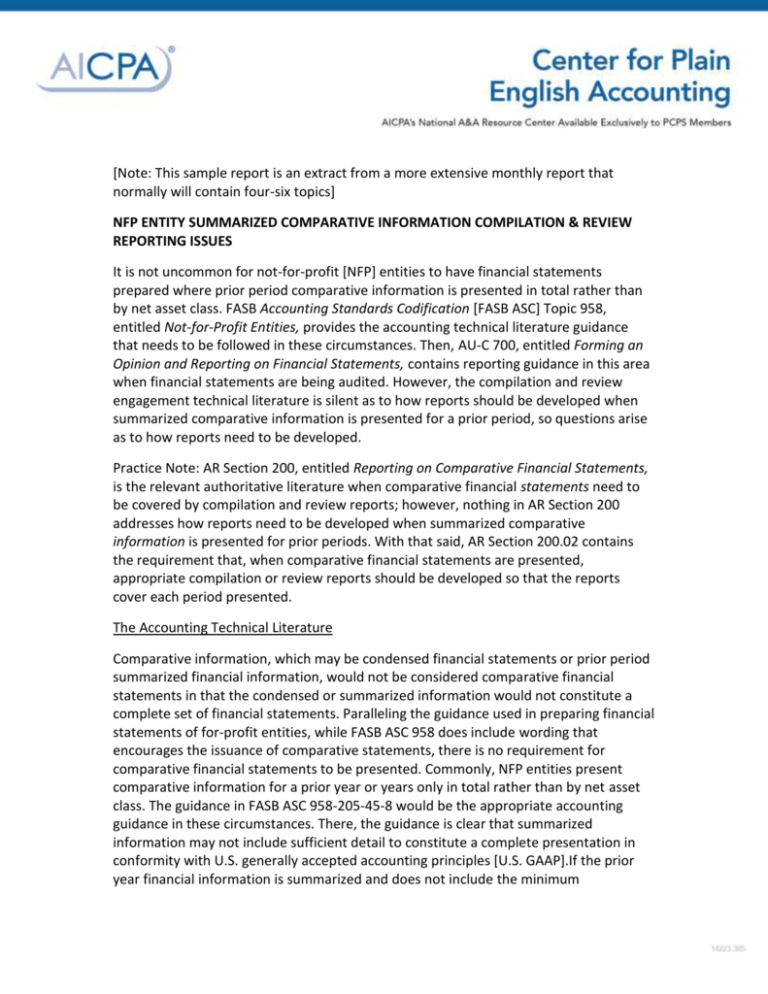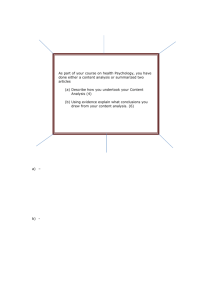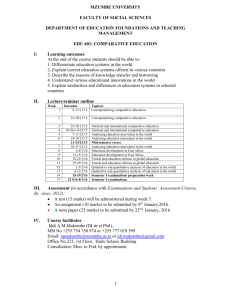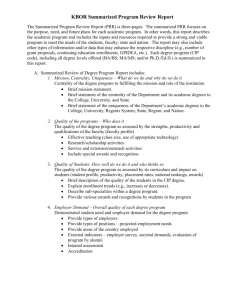
[Note: This sample report is an extract from a more extensive monthly report that
normally will contain four-six topics]
NFP ENTITY SUMMARIZED COMPARATIVE INFORMATION COMPILATION & REVIEW
REPORTING ISSUES
It is not uncommon for not-for-profit [NFP] entities to have financial statements
prepared where prior period comparative information is presented in total rather than
by net asset class. FASB Accounting Standards Codification [FASB ASC] Topic 958,
entitled Not-for-Profit Entities, provides the accounting technical literature guidance
that needs to be followed in these circumstances. Then, AU-C 700, entitled Forming an
Opinion and Reporting on Financial Statements, contains reporting guidance in this area
when financial statements are being audited. However, the compilation and review
engagement technical literature is silent as to how reports should be developed when
summarized comparative information is presented for a prior period, so questions arise
as to how reports need to be developed.
Practice Note: AR Section 200, entitled Reporting on Comparative Financial Statements,
is the relevant authoritative literature when comparative financial statements need to
be covered by compilation and review reports; however, nothing in AR Section 200
addresses how reports need to be developed when summarized comparative
information is presented for prior periods. With that said, AR Section 200.02 contains
the requirement that, when comparative financial statements are presented,
appropriate compilation or review reports should be developed so that the reports
cover each period presented.
The Accounting Technical Literature
Comparative information, which may be condensed financial statements or prior period
summarized financial information, would not be considered comparative financial
statements in that the condensed or summarized information would not constitute a
complete set of financial statements. Paralleling the guidance used in preparing financial
statements of for-profit entities, while FASB ASC 958 does include wording that
encourages the issuance of comparative statements, there is no requirement for
comparative financial statements to be presented. Commonly, NFP entities present
comparative information for a prior year or years only in total rather than by net asset
class. The guidance in FASB ASC 958-205-45-8 would be the appropriate accounting
guidance in these circumstances. There, the guidance is clear that summarized
information may not include sufficient detail to constitute a complete presentation in
conformity with U.S. generally accepted accounting principles [U.S. GAAP].If the prior
year financial information is summarized and does not include the minimum
information required by FASB ASC 958 [e.g., the statement of activities does not present
revenues, expenses, gains, and losses by net asset class], the nature of the prior year
information is required to be described by the use of appropriate titles on the face of
the financial statements and in a note to the financial statements.
Practice Note: FASB ASC 958-205-45-8 contains guidance so that the use of appropriate
titles includes a phrase such as with summarized financial information for the year
ended September 30, 2012, following the title of the statement of column headings that
indicate the summarized nature of the information. There also is the clear stipulation
that labeling the prior year summarized financial information for comparative purposes
only, without further disclosure of the notes to the financial statements, would not
constitute the use of appropriate titles.
An example note to the financial statements that describes the nature of comparative
summarized information to comply with FASB ASC 958 requirements is as follows:
The financial statements include certain prior year summarized
comparative information in total but not by net asset class. Such
information does not include sufficient detail to constitute a
presentation in conformity with accounting principles generally
accepted in the United States of America. Accordingly, such
information should be read in conjunction with the Organization’s
financial statements or the year ended September 30, 2012, from
which the summarized information was derived.
Practice Note: The AICPA Financial Reporting Executive Committee [FinREC]
recommends, when NFP entities present summarized prior year financial information
that is not in sufficient detail to constitute a presentation in conformity with U.S. GAAP,
that all disclosures required by U.S. GAAP for the prior year be included in the financial
statements.
The Auditing Literature as Some Context
The general reporting requirements and guidance under the clarified standards are
found in AU-C 700, as noted earlier. Then, AU-C 705, entitled Modifications to the
Opinion in the Independent Auditor’s Report, addresses how auditors should handle
circumstances resulting in the need to qualify their opinions, issue adverse opinions, or
even disclaim opinions as a result of their audits. Also pertinent to reporting as a result
of many NFP entity audits would be the requirements in AU-C 706, entitled Emphasis-ofMatter Paragraphs and Other-Matter Paragraphs in the Independent Auditor’s Report.
As discussed in the previous section, it is not uncommon for NFP entities to present
comparative financial information for a prior year or years only in total rather than by
net asset class. In these situations, auditors do not issue an opinion on the comparative
information. If prior period financial statement information includes the minimum
information necessary to constitute a complete set of financial statements, the financial
statements are not considered to be summarized information. In these situations,
requirements associated with reporting on comparative financial statements would
apply.
In situations where prior period financial statements are summarized and, as such, do
not include the minimum information required for a complete set of financial
statements, the guidance related to comparative information applies, whereby audit
report wording covering current reporting period does not include mention of the
summarized information. With that said, AU-C 700 does contain the requirement for
auditors to clearly indicate in their audit reports the character of the audit work, if any,
and the degree of responsibility taken in relation to the prior period summarized
information.
Where comparative summarized financial information is presented, and that
information was derived from prior period financial statements that were audited, an
example of an other matter paragraph that would be added to the audit report
following the opinion paragraph is as follows:
Report on Summarized Comparative Information
We have previously audited the Organization’s 2012 financial
statements, and we expressed an unmodified audit opinion on those
audited financial statements in our report dated December 5, 2012.
In our opinion, the summarized comparative information presented
herein as of and for the year ended September 30, 2012 is consistent,
in all material respects, with the audited financial statements from
which it has been derived.
In circumstances where comparative financial information presented was derived from
prior period statements that were not audited, an example of an other matter
paragraph that would be included in the audit report following the opinion paragraph is
as follows:
Report on Summarized Comparative Information
The summarized comparative information presented herein as of and
for the year ended September 30, 2012, derived from those
unaudited financial statements, has not been audited, reviewed, or
compiled and, accordingly, we express no opinion and provide no
assurance on it.
Practice Note: If the prior year financial statements include the minimum information
required by U.S. GAAP for a complete set of financial statements, the financial
statements would not constitute summarized information; accordingly, the audit
reporting requirements related to comparative financial statements would apply.
Alternatively, when the prior year comparative information does not include the
minimum information to constitute a complete set of financial statements, the guidance
related to reporting on comparative information applies. There, the audit report on the
current period statements would not include reference to the summarized comparative
information; in following AU-C 700 requirements, the auditor would need to clearly
indicate in the audit report the character of the audit work, if any, and the degree of
responsibility the auditor is taking in relation to the prior year summarized information.
Developing Compilation & Review Report
As mentioned previously, AR Section 200 of the compilation and review technical
literature is the appropriate guidance when practitioners are engaged to report on
comparative financial statements. In that literature, there is no guidance as to how
practitioners should report on summarized comparative information where that
information does not meet the minimum presentation requirements to comply with U.S.
GAAP. Given that no guidance in this area exists in the technical literature, questions
arise as to how compilation and review reports should be developed to address the
presentation of the comparative information.
Practice Note: The issue relates to how compilation and review reports should be
developed. From a disclosure perspective, in review engagements and in compilation
engagements where management does not elect to omit substantially all disclosures
required by U.S. GAAP, the same type note disclosure would be needed in the financial
statements as would be needed if the statements were audited. Essentially, the level of
attest engagement performed on the financial statements has nothing to do with the
required disclosures needed in the financial statements in order to comply with any
applicable financial reporting framework.
Taking a cue from the auditing technical literature, when practitioners are developing
their compilation and review reports on financial statements that include prior year
comparative information that does not meet the minimum requirements to constitute a
presentation in accordance with U.S. GAAP, the wording in the standard threeparagraph compilation report and four-paragraph review report addressing reporting
responsibilities for the current year would be unchanged. Then, an additional paragraph
would be added to the compilation and review reports to spell-out the character of the
practitioner’s work, if any, and the degree of responsibility being taken, in relation to
the prior year summarized financial information.
In a compilation report, an additional paragraph could include wording such as the
following:
The prior year summarized comparative information has been
derived from the Organization’s 2012 financial statements and, in our
compilation report dated December 5, 2012, we stated that we did
not express an opinion or provide any assurance about whether those
financial statements were in accordance with accounting principles
generally accepted in the United States of America.
In a review report, an additional paragraph could include wording such as the following:
The prior year summarized comparative information has been
derived from the Organization’s 2012 financial statements and, in our
review report dated December 5, 2012, we stated that we were not
aware of any material modifications that should be made to those
financial statements in order for them to be in conformity with
accounting principles generally accepted in the United States of
America.
Practice Note: While the comparative financial information accompanying compiled or
reviewed financial statements issue has not currently been considered in the overall
clarity project related to the compilation and review engagement technical literature, it
would not be unexpected for this issue ultimately to be included in that project. As such,
practitioners should look for additional guidance in this area as the clarified literature is
developed, released, and becomes effective.
October 9, 2013
Center for Plain English Accounting │ www.plainenglishaccounting.com │ cpea@aicpa.org
The CPEA provides non-authoritative guidance on accounting, auditing, attestation, compilation and
review standards. Official AICPA positions are determined through certain specific committee
procedures, due process and extensive deliberation. The views expressed by CPEA staff in this report are
expressed for the purposes of providing member services and other purposes, but not for the purposes
of providing accounting services or practicing public accounting. The CPEA makes no warranties or
representations concerning the accuracy of any reports issued.
Copyright © 2013 by American Institute of Certified Public Accountants, Inc. New York, NY 10036-8775.
All rights reserved.








